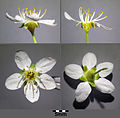Stone softsel
| Stone softsel | ||||||||||||
|---|---|---|---|---|---|---|---|---|---|---|---|---|

Stonosoft ( Prunus mahaleb ) |
||||||||||||
| Systematics | ||||||||||||
|
||||||||||||
| Scientific name | ||||||||||||
| Prunus mahaleb | ||||||||||||
| L. |
The rock cherry , rock or sour cherry ( Prunus mahaleb ) is a plant type from the family of Rosaceae (Rosaceae).
Appearance, features
The Stein Weichsel is a small, 2–6 (up to 10 m) high tree or large shrub . The 4–8 cm long, alternate, often slightly folded and short-stalked leaves are usually glabrous, shiny, ovoid to heart-shaped and pointed and notched on the edge, with short, blunt serrated teeth . The stipules fall off early. There may be glands on the petiole.
The flowers of the stone softsel are mostly hermaphroditic or functionally feminine, so it is gyno-dioecious . The white, about 1 cm wide, fragrant and stalked flowers are five-fold, with a double flower envelope. There are 4–12 of them in a cluster of umbrellas . The green, recessed calyx tips are small and the petals are ovate to elliptical, rounded. The many stamens with white stamens and yellow to orange anthers sit on the edge of the flower cup . The nectar is secreted inside the flower cup. The ovary is medium-sized with a long stylus with a cephalic scar . The round stone fruits of the stone softsel are small, about 8 mm in size and blackish, the stone core (the putamen) about 5 mm in size is smooth. The stone devil blooms around April to May.
The number of chromosomes is 2n = 16.
Occurrence and distribution
The stone softsel occurs from Morocco , Spain and France along the northern Mediterranean area and in the Balkans to Asia Minor and the Middle East. The Central European occurrences are originally limited to the heat-favored regions such as Kaiserstuhl , Altmühltal and Nahe area , in Austria Thermenlinie and Weinviertel .
The stone softsel grows in dry, sunny bushes, hedges and downy oak forests, it is chalky and loves warmth . In Central Europe it is a character species of the Prunetum mahaleb from the Berberidion association, but also occurs in societies of the Quercetalia pubescentis order. Because it is used as an ornamental shrub and grafting base , it can also be found in other places beyond its original range.
use
The stone softsel was formerly mainly used in eastern Austria, Hungary and the Vosges because of its fragrant wood for pipe pipes and walking sticks and was also cultivated for this purpose. The culture method was developed in Baden near Vienna in the early 19th century and became a regionally important special culture. The labor-intensive production of rake rods took place over a period of 4 years on plots of just a few hundred square meters. The last remains of these head tree cultures still exist in northern Burgenland in the Mattersburg area . Today the species is mainly planted as an ornamental wood and used as a base for the cultivation of sour cherries in dry and warm areas. The fruits of the stone softsel are not edible, but in the West Asian region the ground kernels are used as a spice under the name Mahlab , which is also referred to in the scientific name of the species.
Similar species
It can be confused with the common bird cherry ( Prunus padus ), from which it differs in its smooth leaves, the shorter flower cluster and the smooth stone. The bird cherry also prefers significantly more humid locations than the stone softsel.
literature
- Franz Joseph Märter : Characteristics and culture of the mahaleb or perfume cherry tree. (...) Geistinger, Vienna / Trieste 1813. ( digitized version ).
- Regional wood growth (ed.): Die Stein Weichsel - Prunus mahaleb, St. Pölten, 2007, ISBN 3-901542-26-4 .
- Thomas Schauer and Claus Caspari: The BLV plant guide for impassable , BLV-Buchverlag, Munich 2005, ISBN 3-405-16908-9 .
- Werner Rothmaler, Eckehart J. Jäger, and Klaus Werner: Exkursionsflora von Deutschland, Volume 2 , 17th edition, Spectrum Academic Publishing House, Heidelberg - Berlin, 1999 ISBN 978-3-8274-1600-1 .
Individual evidence
- ↑ Prunus mahaleb in Europe: distribution, habitat, usage and threats (PDF), from Data Catalog - European Commission, accessed on August 28, 2019.
- ↑ a b Erich Oberdorfer : Plant-sociological excursion flora for Germany and neighboring areas . 8th edition. Verlag Eugen Ulmer, Stuttgart 2001, ISBN 3-8001-3131-5 . Page 574.
Web links
- Stone softsel. In: FloraWeb.de.
- Profile and distribution map for Bavaria . In: Botanical Information Hub of Bavaria .
- Prunus mahaleb L. In: Info Flora , the national data and information center for Swiss flora . Retrieved November 10, 2015.
- Thomas Meyer: Data sheet with identification key and photos at Flora-de: Flora von Deutschland (old name of the website: Flowers in Swabia )





